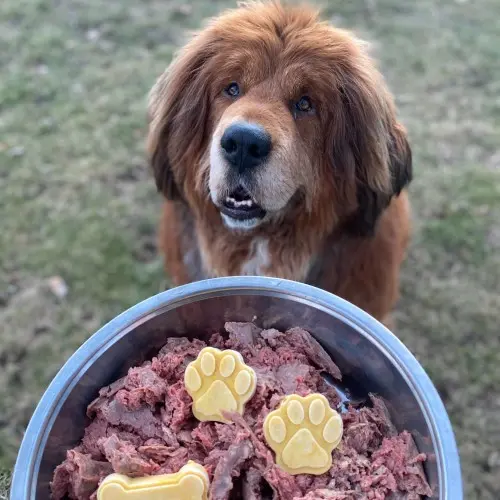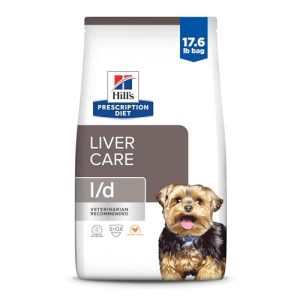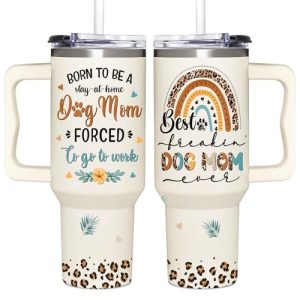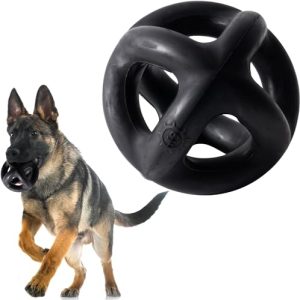Are you concerned about what goes into your senior dog’s bowl? You’re not alone.
Many pet owners like you are exploring different diets to ensure their furry friends stay healthy and happy in their golden years. One option that’s gaining popularity is raw dog food. But is it really good for senior dogs? Before you make any changes, it’s crucial to understand both the benefits and risks associated with this type of diet.
We’ll delve into the world of raw feeding and help you decide if it’s the right choice for your aging companion. Stick around, because your dog’s health and vitality could depend on what you learn next.
Benefits Of Raw Food For Senior Dogs
Raw dog food can be a healthy choice for senior dogs. It often contains fresh ingredients that help support aging bodies.
Feeding raw food may improve digestion, skin, energy, and joint health in older dogs.
Improved Digestion
Raw food is easier for many senior dogs to digest. It contains natural enzymes that help break down food.
This can reduce stomach upset and improve nutrient absorption in older dogs.
Enhanced Coat And Skin Health
Raw diets are rich in omega fatty acids that support healthy skin and a shiny coat. These fats help reduce dryness and itching.
Senior dogs often show better skin condition when eating raw food regularly.
Increased Energy Levels
Raw food gives senior dogs balanced nutrition that can boost their energy. It provides high-quality protein and fats for fuel.
Older dogs may feel more active and lively with a raw food diet.
Joint Health Support
Raw food often contains natural sources of glucosamine and chondroitin. These nutrients help keep joints healthy and reduce stiffness.
Senior dogs with joint problems may experience less pain and better movement on a raw food diet.

Credit: jiminys.com
Potential Risks Of Raw Diets
Feeding raw dog food to senior dogs has risks that owners must know. These risks can affect the dog’s health and safety.
Understanding these risks helps you make safer choices for your older pet’s diet.
Bacterial Contamination
Raw meat can carry harmful bacteria like Salmonella and E. coli. These bacteria can cause serious illness in dogs.
Senior dogs have weaker immune systems, so they get sick more easily from bacteria.
- Bacteria can spread in the kitchen and on surfaces
- Improper handling increases contamination risks
- Signs of infection include vomiting and diarrhea
Nutritional Imbalances
Raw diets might not provide all nutrients senior dogs need. Missing vitamins and minerals can cause health problems.
Older dogs need balanced nutrition to support joints, organs, and energy levels.
- Too much protein can stress kidneys
- Low calcium harms bone health
- Imbalanced fats affect skin and coat
Choking Hazards
Raw bones in the diet can cause choking or blockages. Senior dogs may have weaker teeth and gums.
Chewing hard bones can lead to broken teeth or mouth injuries.
- Small bones can get stuck in the throat
- Sharp bone pieces may cut the digestive tract
- Supervise dogs when eating raw bones
Health Concerns For Immunocompromised Dogs
Dogs with weak immune systems are at higher risk from raw diets. This includes many senior dogs with health issues.
Raw food may expose them to infections that their bodies cannot fight effectively.
- Illnesses may last longer and be more severe
- Some senior dogs take medicines that lower immunity
- Consult a vet before feeding raw food to sick dogs
Nutritional Needs Of Senior Dogs
Senior dogs need special nutrition to stay healthy and active. Their bodies change with age. Good food helps them feel better.
Raw dog food can meet these needs if it has the right balance. Let’s look at key nutrition parts for older dogs.
Protein Requirements
Older dogs need good quality protein for muscle health. Protein supports energy and helps repair tissues. Raw food often has fresh meat that is rich in protein.
Essential Vitamins And Minerals
Senior dogs need vitamins and minerals for strong bones and good immunity. Important nutrients include calcium, phosphorus, and vitamins A, E, and B-complex.
- Calcium supports bone strength
- Vitamin E acts as an antioxidant
- Vitamin B helps with energy and metabolism
- Phosphorus works with calcium for bones
Calorie Considerations
| Age | Activity Level | Calorie Needs (per day) |
| 7-10 years | High | 1400-1600 |
| 7-10 years | Low | 1100-1300 |
| 10+ years | High | 1200-1400 |
| 10+ years | Low | 900-1100 |
Senior dogs burn fewer calories. Raw food calories must match their activity to avoid weight gain or loss.
Hydration Importance
Water is vital for senior dogs. It helps digestion and keeps joints healthy. Raw food has more moisture than dry food, aiding hydration.
- Always provide fresh water
- Feed raw food with natural moisture
- Watch for signs of dehydration

Credit: blog.homesalive.ca
Choosing The Right Raw Ingredients
Feeding raw food to senior dogs needs careful planning. Choosing the right ingredients helps keep them healthy and active.
Senior dogs have different needs than younger ones. Their diet must support aging joints and digestion.
Meat Selection
Choose lean meats for senior dogs. These provide protein without extra fat. Chicken, turkey, and lean beef are good choices.
Rotate meat types to offer different nutrients. Avoid fatty or processed meats to protect your dog’s health.
Inclusion Of Organs And Bones
Organs supply important vitamins and minerals. Liver, kidney, and heart are rich in nutrients seniors need.
- Include a small amount of organs, about 10-15% of the diet
- Raw bones support dental health and provide minerals
- Use bones that are safe and easy to chew, like chicken necks
- Never give cooked bones, they can splinter and cause harm
Vegetables And Supplements
Vegetables add fiber and antioxidants. Good choices include carrots, spinach, and pumpkin.
| Vegetable | Benefit |
| Carrots | Support eye health |
| Spinach | Rich in iron and vitamins |
| Pumpkin | Aids digestion |
Supplements like fish oil help joint health. Consult your vet before adding any supplements.
Avoiding Harmful Foods
Some foods hurt senior dogs. Avoid onions, garlic, grapes, and chocolate. These cause illness or worse.
- Do not feed cooked bones or fatty meats
- Avoid raw fish that may carry parasites
- Skip foods with added salt or spices
- Never give sweets or dairy products
Transitioning To A Raw Diet Safely
Switching senior dogs to a raw food diet needs care and patience. The process takes time to help their bodies adjust well.
Knowing how to introduce raw food safely can keep your dog healthy and happy during the change.
Gradual Introduction Tips
Start by mixing small amounts of raw food with your dog’s current diet. Increase raw food slowly over weeks.
- Begin with 10% raw food and 90% regular food.
- Watch for any digestive upset like vomiting or diarrhea.
- Raise the raw food to 25% after one week if no issues appear.
- Keep increasing by 10-15% weekly until full raw diet is reached.
Monitoring Health Changes
Observe your senior dog’s energy, stool quality, and coat condition during the diet switch. These signs show how well they adapt.
| Health Aspect | What to Watch |
| Energy Level | More active or tired |
| Stool | Firm and regular or loose and irregular |
| Coat | Shiny and smooth or dry and dull |
| Appetite | Eating well or refusing food |
Consulting A Veterinarian
Talk to your vet before changing your dog’s diet. They can give advice based on your dog’s health and age.
Your vet may recommend:
- Blood tests to check organ function
- Supplements to balance nutrients
- A customized feeding plan
Adjusting Portions
Senior dogs need portion sizes that match their activity and health. Raw food portions may differ from kibble amounts.
- Start with smaller portions and increase as needed.
- Watch your dog’s weight weekly to avoid overfeeding.
- Adjust portions if your dog gains or loses weight.
Commercial Raw Diet Options
Raw dog food has gained attention as a choice for senior dogs. Many owners look for easy options to feed a raw diet. Commercial raw food makes feeding simpler and more convenient.
This article reviews types of commercial raw food. It covers brands, freeze-dried foods, quality checks, and costs. Understanding these helps pick the right food for older dogs.
Pre-made Raw Food Brands
Several companies sell raw food that is ready to serve. These brands offer frozen or refrigerated meals made from meat, bones, and vegetables. They save time on preparation.
Popular brands often include balanced nutrients for senior dogs. Some add supplements for joint health and digestion. Packaging usually shows ingredients clearly.
Freeze-dried And Dehydrated Choices
Freeze-dried and dehydrated raw foods are dry but keep nutrients. They need water added before feeding. These forms last longer on shelves and are easy to store.
- Freeze-dried food keeps most vitamins and minerals.
- Dehydrated options are lighter and less bulky.
- Both types offer convenience for travel or storage.
- They often come in smaller packages for portion control.
Evaluating Quality And Safety
Quality is key for senior dogs on raw diets. Look for foods with clear sources of meat and no fillers. Safety also matters to avoid bacteria or contamination.
| Factor | What to Check |
| Ingredients | High meat content, no artificial additives |
| Packaging | Vacuum-sealed or frozen to keep freshness |
| Brand Reputation | Reviews and recalls history |
| Expiration Date | Freshness before use |
| Storage Instructions | Proper freezing or refrigeration needed |
Cost Considerations
Raw diets for senior dogs can be costly. Prices vary by brand, food type, and package size. Understanding costs helps plan a budget for feeding raw.
- Pre-made frozen raw food usually costs more per pound.
- Freeze-dried and dehydrated foods cost more upfront but store longer.
- Buying in bulk may reduce the price per serving.
- Check if shipping or refrigeration fees apply.
Homemade Raw Diet Recipes
Feeding senior dogs a homemade raw diet can support their health and energy. This diet includes fresh, natural ingredients that are easy to digest.
Creating balanced meals at home helps you control what your dog eats. It can improve their coat, digestion, and overall well-being.
Simple Balanced Meal Ideas
Make meals with a good mix of protein, fat, and vegetables. Use different meats like chicken, turkey, or beef. Add veggies like carrots and spinach for vitamins.
- Raw chicken or turkey (muscle meat and organ meat)
- Ground beef or lamb
- Chopped vegetables such as carrots, broccoli, and green beans
- Small amounts of fruit like blueberries or apple slices
- Raw eggs or fish oil for extra nutrients
Supplementing Nutrients
Senior dogs may need extra nutrients for strong bones and joints. Add supplements like fish oil for omega-3 fatty acids and glucosamine for joint health.
| Supplement | Purpose | How to Use |
| Fish Oil | Improves coat and reduces inflammation | Add 1 teaspoon per 10 pounds of dog weight |
| Glucosamine | Supports joint health | Give as powder or capsule daily |
| Calcium Powder | Strengthens bones | Mix with meals as directed on package |
Storage And Handling Tips
Keep raw food safe by storing it at the right temperature. Use clean containers and wash hands before and after handling. Freeze extra portions to keep them fresh.
- Store raw meat in sealed containers in the freezer
- Defrost meals in the refrigerator overnight
- Clean all surfaces and utensils after use
- Serve food at room temperature for better digestion
Ensuring Variety
Offer different proteins and vegetables to prevent boredom and provide full nutrition. Rotate meats like beef, chicken, and fish. Change vegetables weekly to add new vitamins.
Try this weekly rotation plan:
- Monday & Thursday: Chicken with carrots and peas
- Tuesday & Friday: Beef with spinach and green beans
- Wednesday & Saturday: Fish with pumpkin and zucchini
- Sunday: Mix of organ meats with small fruit portions

Credit: blog.homesalive.ca
Signs Raw Food Is Benefiting Your Senior Dog
Switching to raw dog food can affect your senior dog’s health in many ways. Not all changes are easy to see at first.
Look for clear signs that your dog is feeling better and acting more like their younger self.
Improved Mobility
Raw food can reduce joint pain and stiffness in older dogs. You may notice they move with less effort and play more.
Better Coat Condition
A shiny, soft coat is a sign of good health. Raw food provides natural oils and nutrients that support skin and fur.
- Less shedding
- Fewer dry spots
- Brighter, glossier fur
Weight Management
Raw food helps maintain a healthy weight by offering balanced protein and fat. This keeps muscles strong and avoids excess fat.
| Weight Change | Possible Cause | Benefit of Raw Food |
|---|---|---|
| Weight Loss | Improved digestion | Better nutrient absorption |
| Weight Gain | Balanced calories | Muscle gain, not fat |
| Stable Weight | Healthy metabolism | Consistent energy levels |
Enhanced Vitality
Your senior dog may show more energy and alertness after switching to raw food. They might enjoy walks and playtime more.
Signs of increased vitality include:
- Longer active periods
- Improved mood and curiosity
- Faster recovery after exercise
When Raw Food May Not Be Suitable
Raw dog food can be healthy, but it is not for every senior dog. Some dogs have special needs that raw diets might not meet.
Before switching to raw food, consider your dog’s health, eating habits, and your ability to provide safe meals.
Underlying Health Issues
Senior dogs with certain health problems may not do well on raw diets. Conditions like kidney disease, digestive troubles, or weak immune systems can make raw food risky.
- Dogs with kidney or liver problems may need special diets.
- Raw food can contain bacteria that harm dogs with weak immunity.
- Digestive issues may worsen with raw food due to bacteria and bones.
Picky Eaters
Some senior dogs refuse raw food because of its smell or texture. This can make mealtime stressful for you and your dog.
It is important to respect your dog’s preferences and find an alternative diet if needed.
Limited Access To Quality Ingredients
Raw food must be fresh and from safe sources. If you cannot get high-quality meat and produce, raw feeding is not safe.
| Ingredient | Quality Check | Risk if Poor Quality |
|---|---|---|
| Meat | Fresh, no odors, from trusted supplier | Bacterial infection, parasites |
| Vegetables | Clean, organic preferred | Pesticide exposure |
| Supplements | Proper storage and expiry date | Imbalance in nutrients |
Veterinary Restrictions
Some vets advise against raw food for senior dogs. This advice is based on health concerns or risks of bacterial infections.
- Dogs with certain diseases may need cooked or special diets.
- Raw food may interfere with medications or treatments.
- Vets may require lab tests before approving raw feeding.
Frequently Asked Questions
Is Raw Dog Food Safe For Senior Dogs?
Raw dog food can be safe if balanced and handled properly. It supports digestion and joint health but consult your vet first. Hygiene and quality are crucial to avoid infections and nutrient deficiencies.
What Are The Benefits Of Raw Food For Older Dogs?
Raw food improves coat shine, energy levels, and digestion. It provides natural nutrients and enzymes that processed foods may lack. This diet can enhance senior dogs’ overall vitality and immune system.
Can Raw Food Cause Health Risks In Senior Dogs?
Raw food may carry bacteria like Salmonella if not prepared safely. Older dogs with weak immunity are more vulnerable. Proper sourcing, handling, and vet guidance reduce these risks significantly.
How To Transition Senior Dogs To Raw Food Safely?
Switch gradually over 7-10 days, mixing raw with current food. Monitor for digestive upset or allergies during this period. Always consult your vet before changing your senior dog’s diet.
Conclusion
Raw dog food can support senior dogs’ health well. It offers natural nutrients and better digestion. Some dogs enjoy the taste and energy boost. Always check with your vet before changing diets. Watch your dog’s response closely for any issues.
Balance and safety matter most for older pets. Choose quality ingredients to avoid risks. Feeding raw needs care and knowledge. Done right, it may improve your dog’s life. Consider all factors before deciding on raw food.

Emily Barker is the founder of ChillDogLife.com, a space dedicated to helping pup parents discover the best dog products, lifestyle tips, and cozy ideas for happier homes.
A lifelong dog lover, Emily combines her passion for pets with a knack for research to share trusted recommendations on everything from toys and furniture to health and everyday care.
Her goal is simple: to make life easier, stylish, and more joyful for dogs and the people who love them.







